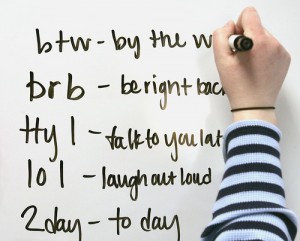 Eric Rodriguez is the voice of The Millennial View here at Management Excellence. His periodic posts offer observations and guidance for early career professionals in the workplace. For those slightly more experienced professionals, Eric’s posts offer ideas and insights for working with the youngest members of your organization.
Eric Rodriguez is the voice of The Millennial View here at Management Excellence. His periodic posts offer observations and guidance for early career professionals in the workplace. For those slightly more experienced professionals, Eric’s posts offer ideas and insights for working with the youngest members of your organization.
Last weekend at my grandfather’s 80th birthday party my aunt discussed an issue she had with younger professionals in her workplace.
“Why do some of you kids feel the need to use texting acronyms in everything?” my aunt said. “Sometimes I get emails at work and I don’t understand what you’re trying to say, what does FWIW stand for?”
FWIW means “For What It’s Worth” and my aunt was joking about her frustration, but there is truth in what she said. More and more people are starting to notice a steady trickle of texting acronyms in business emails and conversations. Last week my mom complained about a coworker who used texting abbreviations in emails when she responded to business matters.
 Younger professionals (Millennials and Gen Z) are most comfortable with texting acronyms, because we grew up using them through instant messaging and then on our phones. We didn’t invent texting, but we contributed a lot to it. By searching “texting acronyms” an online texting dictionary can be found that has tons of unique abbreviations created in the last decade. One of my favorites is *$, it means Starbucks.
Younger professionals (Millennials and Gen Z) are most comfortable with texting acronyms, because we grew up using them through instant messaging and then on our phones. We didn’t invent texting, but we contributed a lot to it. By searching “texting acronyms” an online texting dictionary can be found that has tons of unique abbreviations created in the last decade. One of my favorites is *$, it means Starbucks.
Acronyms are fun and it makes communicating easier, especially when you’re in a hurry. But, when it comes to sending business emails or even talking in the workplace people should probably leave the texting abbreviations to their phones and Facebook walls.
Use of texting acronyms causes a breakdown in communication, and three problems that arise from its use are:
1. Some coworkers, especially those who don’t text, have no idea what these acronyms mean
2. People who use these abbreviations appear lazy and inarticulate to others.
3. Management and coworkers probably won’t be too happy trying to decipher texting acronyms to find out what the messenger is trying to say
Texting abbreviations have absolutely no place in the workplace, and while no one is going to be sent to a gulag for putting an acronym or emoticon (:D) in an email. It is probably a good idea that this behavior never gets used in the office.
None of us could imagine picking up a copy of the newspaper and seeing a headline read “OMG Goldman Sachs Predicts $5.00 A Gallon Gas This Summer,” or downloading a book on an iPad and realizing that the author thought it would be less strenuous to use u instead of you because it’s easier to write that way.
If we wouldn’t want to see the above examples happen, why would anyone want to display texting acronyms in an email, especially one that concerns business?
These abbreviations have no place in good communication; it is confusing to others, sometimes it’s rude, and often it’s unprofessional. Proper correspondence is a component of success and the acronyms should be left for our thumbs and the writing for our fingertips – JMO, Just My Opinion.






LMAO! Well duh!
Patricia, this is a LOL moment for a lot of us because using abbreviations in a workplace setting should be a known act of unprofessional behavior. I remember one time when I used texting acronyms in my response to an email regarding the company picnic; I thought it was ok because it was a “fun event,” but now when I look back on it I cringe, ugh.
Talk about not knowing what some of the acronyms mean… I’m a Gen Y-er and I will never forget when I received a business email from a collegue 20+ years older than me that said: Thx…HNY. I thought he was calling me HONEY! Talk about awkward, until someone clued me in that he probably meant Happy New Year!
Kasey, I’m still chuckling at your note. I thought it meant the same thing! -Art
Kasey, thx 4 commenting on my post HNY jk. Yeah, I think your boss needs to find a new way to say Happy New Year or be faced with a lawsuit one day. Like you and Art HNY means honey to me.